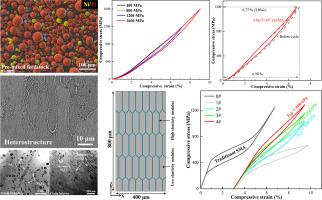通过晶界改性增材制备具有准线性超弹性和循环稳定性的双区NiTi合金
IF 14.3
1区 材料科学
Q1 MATERIALS SCIENCE, MULTIDISCIPLINARY
引用次数: 0
摘要
具有超高强度和循环稳定性的高富镍NiTi合金在弹热制冷和能量转换行业中是必不可少的。然而,强度和超弹性应变之间的内在权衡往往使协同增强的努力复杂化。本文采用激光粉末床熔合(LPBF)制备了一种原位合金化双区Ti-55Ni (at.%)合金,其特征是富镍析出物分布不均匀。该合金的模量为27 GPa,表现出准线性超弹性,弹性应变超过9% (1600 MPa下),在建筑方向上的循环稳定性超过2 × 105次(1200 MPa下)。多尺度显微分析表明,这种优异的力学性能是由于特殊的异质微观结构。在LPBF原位循环热处理过程中,高模量Ni3Ti和Ni3Ti2相作为非转变区主要脱离晶界,而低模量的Ni4Ti3初生相和次生相析出于柱状晶粒内部。基于其独特的分布特征,通过有限元模拟阐明了高原型超弹性向准线性型超弹性的转变以及高模晶界对准线性超弹性行为的贡献。这项工作有望为设计和制造新型超弹性材料提供一种实用可行的方法。本文章由计算机程序翻译,如有差异,请以英文原文为准。

Additively manufactured dual-area NiTi alloys with quasi-linear superelasticity and cyclic stability via grain boundary modification
Highly nickel-rich NiTi alloys with ultrahigh strength and cyclic stability are essential for elastocaloric refrigeration and energy conversion industries. However, the inherent trade-off between strength and superelastic strain often complicates efforts to enhance synergistically. Here, an in-situ alloying dual-area Ti-55Ni (at.%) alloy, characterized by non-uniformly distributed Ni-rich precipitates, is fabricated using laser powder bed fusion (LPBF) with pre-mixed feedstock. The alloy, exhibiting a modulus of 27 GPa, demonstrates quasi-linear superelasticity with an impressive elastic strain exceeding 9% (under 1600 MPa) and exceptional cyclic stability over 2 × 105 cycles (under 1200 MPa) in the building direction. This remarkable mechanical performance is attributed to the specialized heterogeneous microstructure, as revealed through multi-scale microscopic analysis. During in-situ cyclic heat treatment of LPBF, the high-modulus Ni3Ti and Ni3Ti2 phases, as a non-transforming area, mainly separate from the grain boundaries, while the primary and secondary Ni4Ti3 phases with low modulus precipitate within the columnar grain interiors. Given the unique distribution characteristic, the transition of superelasticity from plateau-type to quasi-linear one and the contribution of the high-modulus grain boundaries to quasi-linear superelastic behavior are elucidated through finite element simulations. This work is anticipated to offer a practical and feasible approach for designing and fabricating novel superelastic materials.
求助全文
通过发布文献求助,成功后即可免费获取论文全文。
去求助
来源期刊

Journal of Materials Science & Technology
工程技术-材料科学:综合
CiteScore
20.00
自引率
11.00%
发文量
995
审稿时长
13 days
期刊介绍:
Journal of Materials Science & Technology strives to promote global collaboration in the field of materials science and technology. It primarily publishes original research papers, invited review articles, letters, research notes, and summaries of scientific achievements. The journal covers a wide range of materials science and technology topics, including metallic materials, inorganic nonmetallic materials, and composite materials.
 求助内容:
求助内容: 应助结果提醒方式:
应助结果提醒方式:


